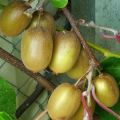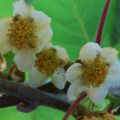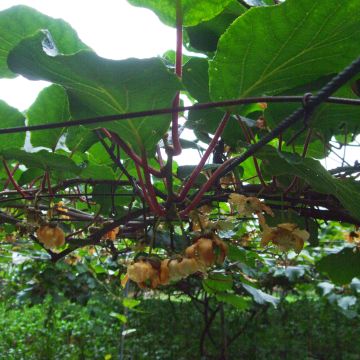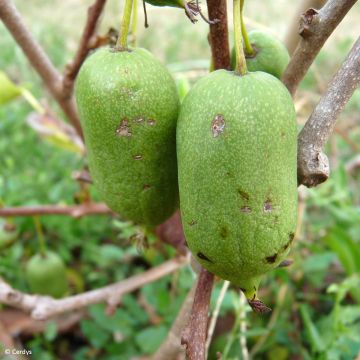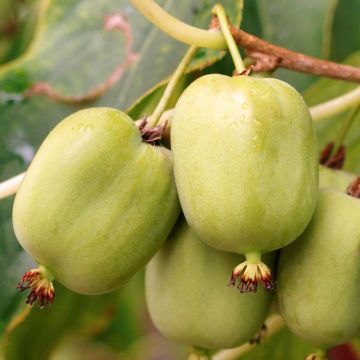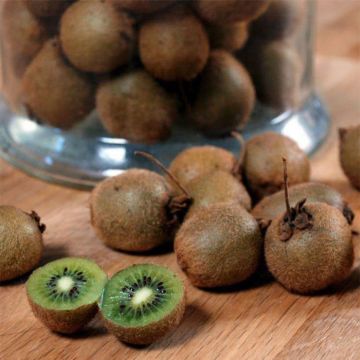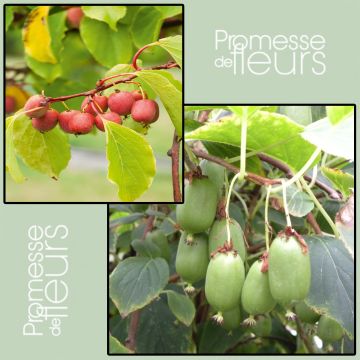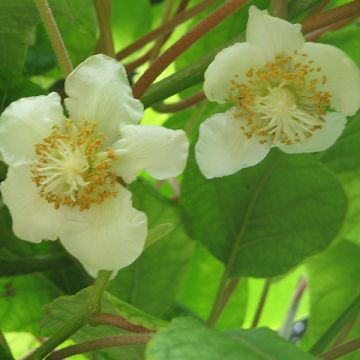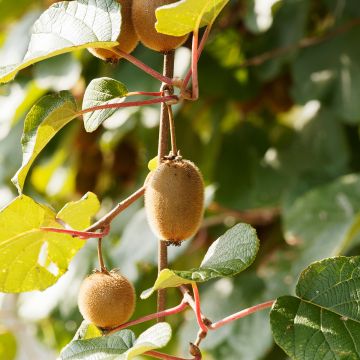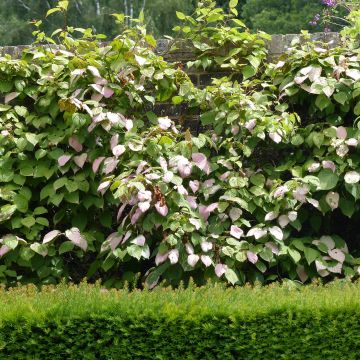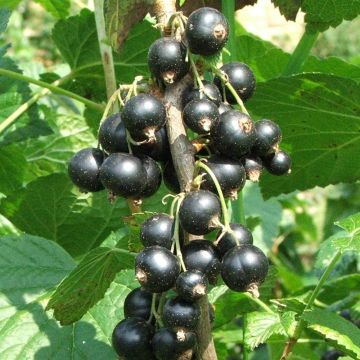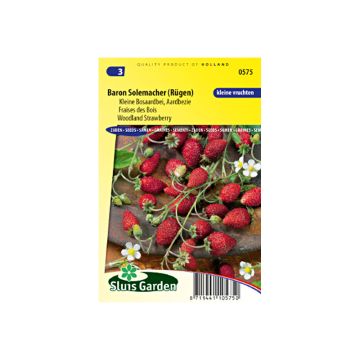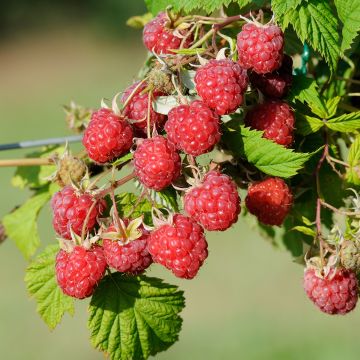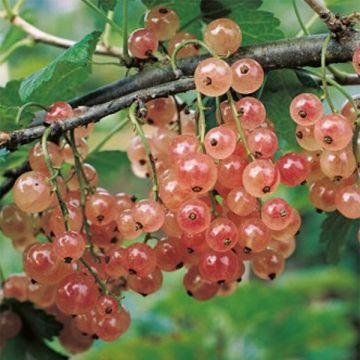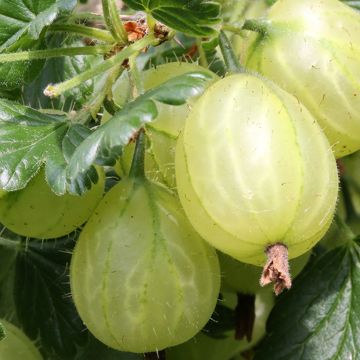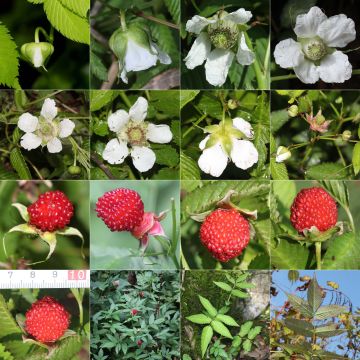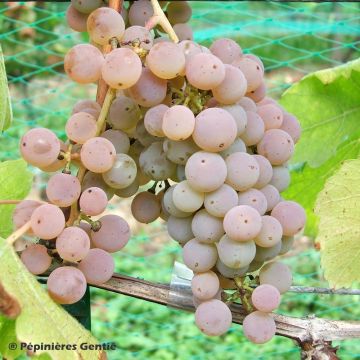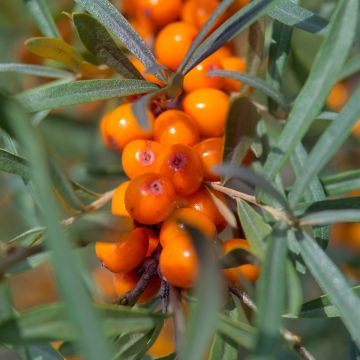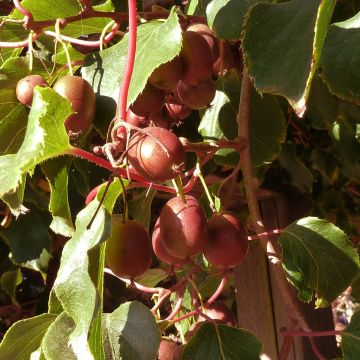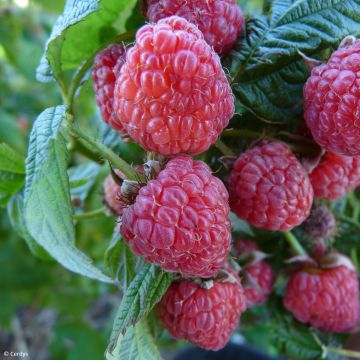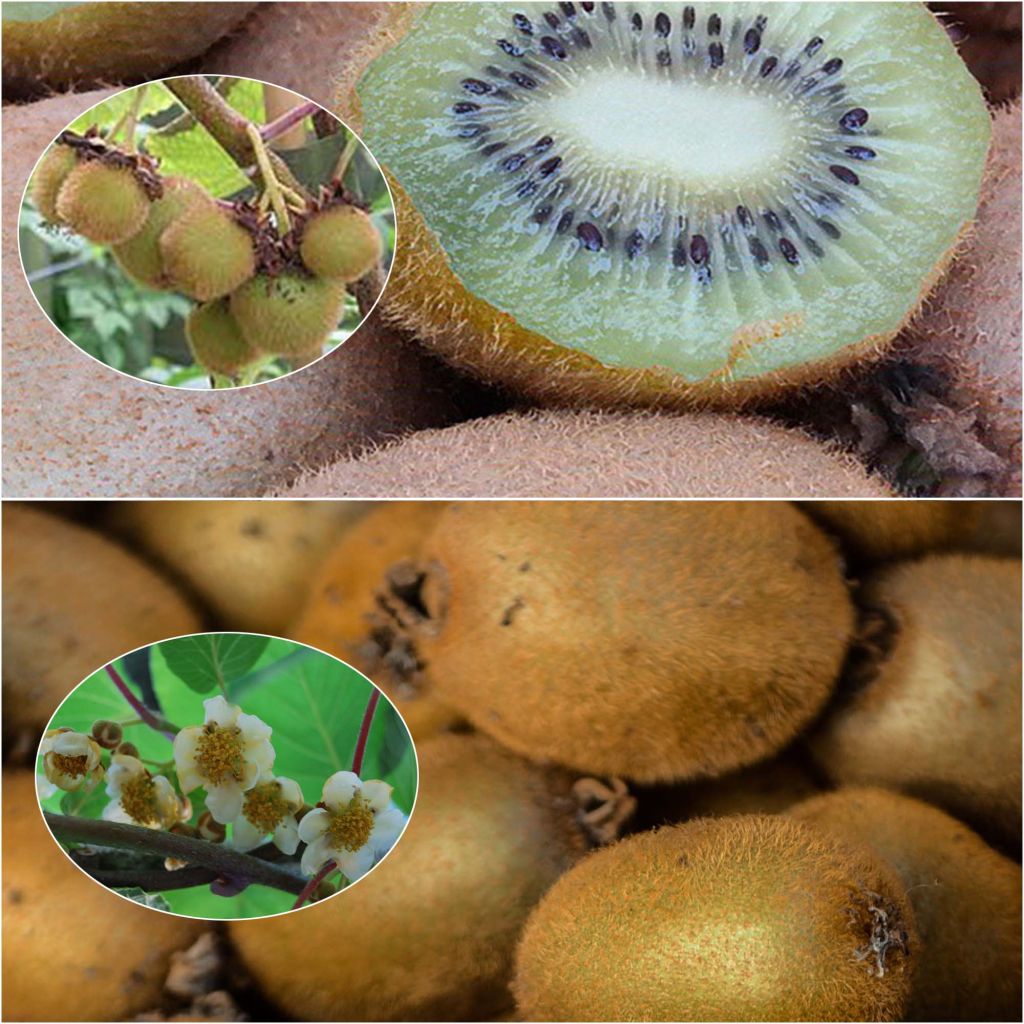

Duo of Female 'Hayward' and Male Pollinator 'Atlas' Kiwi Plants
Duo of Female 'Hayward' and Male Pollinator 'Atlas' Kiwi Plants
Actinidia deliciosa
Chinese gooseberry, Kiwi fruit, Yangtoa
The male and female plants have died.
valerie, 09/09/2024
This item cannot be shipped to the selected country
Delivery charge from €5.90
More information
Schedule delivery date,
and select date in basket
This plant carries a 6 months recovery warranty
More information
We guarantee the quality of our plants for a full growing cycle, and will replace at our expense any plant that fails to recover under normal climatic and planting conditions.
From €5.90 for pickup delivery and €6.90 for home delivery
Express home delivery from €8.90.
Collection items (2 plants)
Description
A duo of kiwi (Actinidia deliciosa) plants, with 'Atlas' and 'Hayward' varieties. Atlas' is a male plant that pollinates the 'Hayward' female plant, which then produces large, delicious fruits with green flesh that can be stored. It is ideal to train along a pergola, trellis, or arbour. Planting is best done in autumn or any time of the year when there is no risk of frost, for a harvest around November, starting from the 4th or 5th year.
Actinidia deliciosa, also known as Chinese gooseberry, yang tao, or vegetable mouse, belongs to the Actinidiaceae family, just like its cousin the Kiwai (Actinidia arguta). Originating from China, the kiwi is a vigorous climbing liana that can grow up to 3m (10ft) per year under favourable conditions. This climbing plant needs to be trained on a sturdy support, such as a wall with strong wires, a trellis, an arbour, a tree trunk, or a fence. It can reach a height of 6m (20ft) and a spread of 4m (13ft) and requires pruning to control its growth.
Some varieties are self-fertile (male and female flowers on the same plant) and can be planted alone. Other varieties bear either male flowers (like 'Atlas') or female flowers (like 'Hayward') and require the presence of a plant of the opposite sex for pollination. One male plant can pollinate approximately 5 to 6 female plants. Only female plants produce fruits.
The kiwi is very hardy, able to withstand temperatures as low as -15°C (5°F) but is sensitive to late frosts, as the buds freeze at -5°C (23°F). Its foliage is deciduous. The stems bear large, ovate, entire leaves with a dark matte green colour on the upper side and a lighter shade underneath, covered with small red hairs, just like the stems. From the third or fourth year of cultivation, clusters of fragrant flowers appear in May-June on the previous year's branches. These flowers have broad, cream-white petals. Male flowers have numerous yellow stamens, while female flowers have white stigmas.
On female plants, flowering is followed by the formation of large, fleshy, ovoid berries weighing approximately 60 grams. The skin is light brown and velvety for the Actinidia deliciosa species (or smooth for the Actinidia chinensis species). The flesh is green, sometimes yellow for certain varieties, and contains numerous small black seeds. Kiwi fruits are rich in vitamin C, fibre, and minerals such as potassium, magnesium, and calcium. Harvesting takes place around November, before the frosts. The fruits can be picked even if they are still green as they continue to ripen after harvest. They store well in a cool place at 5°C (41°F), such as a cellar, for over a month. Kiwis are ripe when they are soft to the touch. Place kiwis next to apples or bananas to speed up their ripening. Once peeled, kiwis can be enjoyed as is or mixed with other autumn fruits, used in jams, or used to decorate pies and certain savoury dishes.
Report an error about the product description
Plant habit
Fruit
Flowering
Foliage
Botanical data
Actinidia
deliciosa
Actinidiaceae
Chinese gooseberry, Kiwi fruit, Yangtoa
Central Asia
Other Kiwi bush
Planting and care
Ideally, plant in autumn. However, planting can be done throughout the year except during freezing periods. It thrives in cool, rich, light, and well-drained soil that is not chalky. The plant fears stagnant humidity. Place it in a sunny position sheltered from strong winds. Space the plants 3 to 4m (10 to 13ft) apart.
Dig a hole 50cm (20in) in all directions. Spread a layer of gravel at the bottom, then a layer of soil mixed with turf or compost. Place the root ball (the collar of the plant should be at ground level) and cover with soil. Provide it with a sturdy support to help its voluble branches climb. Firmly tamp down the soil and water generously. It has trailing roots that develop horizontally below the surface of the soil, which may require light surface hoeing if necessary. Mulch the base of the plants for the first three winters.
It requires little maintenance, simply provide regular watering. During periods of high heat, water it 1 to 2 times a week. Once established and rooted, the plant will fend for itself and become less water-hungry. In late winter, lightly incorporate organic fertiliser or well-decomposed manure into the soil at the base of the plant. Train the shoots as they grow by tying them to the support, without tightening them too much. They will wrap around the support.
Resistant to insects and pests, it can, however, be susceptible to red spider mites in a hot and dry environment. To eliminate them, lightly mist the foliage and soil regularly.
Planting period
Intended location
Care
-
, onOrder confirmed
Reply from on Promesse de fleurs
Berries
Haven't found what you were looking for?
Hardiness is the lowest winter temperature a plant can endure without suffering serious damage or even dying. However, hardiness is affected by location (a sheltered area, such as a patio), protection (winter cover) and soil type (hardiness is improved by well-drained soil).

Photo Sharing Terms & Conditions
In order to encourage gardeners to interact and share their experiences, Promesse de fleurs offers various media enabling content to be uploaded onto its Site - in particular via the ‘Photo sharing’ module.
The User agrees to refrain from:
- Posting any content that is illegal, prejudicial, insulting, racist, inciteful to hatred, revisionist, contrary to public decency, that infringes on privacy or on the privacy rights of third parties, in particular the publicity rights of persons and goods, intellectual property rights, or the right to privacy.
- Submitting content on behalf of a third party;
- Impersonate the identity of a third party and/or publish any personal information about a third party;
In general, the User undertakes to refrain from any unethical behaviour.
All Content (in particular text, comments, files, images, photos, videos, creative works, etc.), which may be subject to property or intellectual property rights, image or other private rights, shall remain the property of the User, subject to the limited rights granted by the terms of the licence granted by Promesse de fleurs as stated below. Users are at liberty to publish or not to publish such Content on the Site, notably via the ‘Photo Sharing’ facility, and accept that this Content shall be made public and freely accessible, notably on the Internet.
Users further acknowledge, undertake to have ,and guarantee that they hold all necessary rights and permissions to publish such material on the Site, in particular with regard to the legislation in force pertaining to any privacy, property, intellectual property, image, or contractual rights, or rights of any other nature. By publishing such Content on the Site, Users acknowledge accepting full liability as publishers of the Content within the meaning of the law, and grant Promesse de fleurs, free of charge, an inclusive, worldwide licence for the said Content for the entire duration of its publication, including all reproduction, representation, up/downloading, displaying, performing, transmission, and storage rights.
Users also grant permission for their name to be linked to the Content and accept that this link may not always be made available.
By engaging in posting material, Users consent to their Content becoming automatically accessible on the Internet, in particular on other sites and/or blogs and/or web pages of the Promesse de fleurs site, including in particular social pages and the Promesse de fleurs catalogue.
Users may secure the removal of entrusted content free of charge by issuing a simple request via our contact form.
The flowering period indicated on our website applies to countries and regions located in USDA zone 8 (France, the United Kingdom, Ireland, the Netherlands, etc.)
It will vary according to where you live:
- In zones 9 to 10 (Italy, Spain, Greece, etc.), flowering will occur about 2 to 4 weeks earlier.
- In zones 6 to 7 (Germany, Poland, Slovenia, and lower mountainous regions), flowering will be delayed by 2 to 3 weeks.
- In zone 5 (Central Europe, Scandinavia), blooming will be delayed by 3 to 5 weeks.
In temperate climates, pruning of spring-flowering shrubs (forsythia, spireas, etc.) should be done just after flowering.
Pruning of summer-flowering shrubs (Indian Lilac, Perovskia, etc.) can be done in winter or spring.
In cold regions as well as with frost-sensitive plants, avoid pruning too early when severe frosts may still occur.
The planting period indicated on our website applies to countries and regions located in USDA zone 8 (France, United Kingdom, Ireland, Netherlands).
It will vary according to where you live:
- In Mediterranean zones (Marseille, Madrid, Milan, etc.), autumn and winter are the best planting periods.
- In continental zones (Strasbourg, Munich, Vienna, etc.), delay planting by 2 to 3 weeks in spring and bring it forward by 2 to 4 weeks in autumn.
- In mountainous regions (the Alps, Pyrenees, Carpathians, etc.), it is best to plant in late spring (May-June) or late summer (August-September).
The harvesting period indicated on our website applies to countries and regions in USDA zone 8 (France, England, Ireland, the Netherlands).
In colder areas (Scandinavia, Poland, Austria...) fruit and vegetable harvests are likely to be delayed by 3-4 weeks.
In warmer areas (Italy, Spain, Greece, etc.), harvesting will probably take place earlier, depending on weather conditions.
The sowing periods indicated on our website apply to countries and regions within USDA Zone 8 (France, UK, Ireland, Netherlands).
In colder areas (Scandinavia, Poland, Austria...), delay any outdoor sowing by 3-4 weeks, or sow under glass.
In warmer climes (Italy, Spain, Greece, etc.), bring outdoor sowing forward by a few weeks.

































